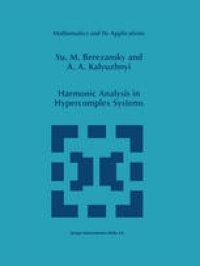
Ebook: Harmonic Analysis in Hypercomplex Systems
- Tags: Abstract Harmonic Analysis, Analysis
- Series: Mathematics and Its Applications 434
- Year: 1998
- Publisher: Springer Netherlands
- Edition: 1
- Language: English
- pdf
First works related to the topics covered in this book belong to J. Delsarte and B. M. Le vitan and appeared since 1938. In these works, the families of operators that generalize usual translation operators were investigated and the corresponding harmonic analysis was constructed. Later, starting from 1950, it was noticed that, in such constructions, an important role is played by the fact that the kernels of the corresponding convolutions of functions are nonnegative and by the properties of the normed algebras generated by these convolutions. That was the way the notion of hypercomplex system with continu ous basis appeared. A hypercomplex system is a normed algebra of functions on a locally compact space Q-the "basis" of this hypercomplex system. Later, similar objects, hypergroups, were introduced, which have complex-valued measures on Q as elements and convolution defined to be essentially the convolution of functionals and dual to the original convolution (if measures are regarded as functionals on the space of continuous functions on Q). However, until 1991, the time when this book was written in Russian, there were no monographs containing fundamentals of the theory (with an exception of a short section in the book by Yu. M. Berezansky and Yu. G. Kondratiev [BeKo]). The authors wanted to give an introduction to the theory and cover the most important subsequent results and examples.
This monograph is devoted to the theory of hypercomplex systems with locally compact basis. Such systems were introduced by Yu. Berezansky and S. Krein in the 1950s and are a generalisation of the notion of a hypergroup (a family of generalised shift operators) which was introduced in the 1970s.
The book gives a state-of-the-art account of hypercomplex systems theory. After the introductory chapter, it treats the Lie theory of hypercomplex systems and examples. Topics covered include Fourier transforms, the Plancherel theorem, the Peter-Weyl theorem, representation theory, duality, Gelfand pairs, Sturm-Liouville operators, and Lie theory. New proofs of results concerning Tannaka-Krein duality and Gelfand pairs are given. On the basis of this theory, new approaches to the construction of harmonic analysis on well-known objects become possible.
Audience: This volume will be of interest to researchers and graduate students involved in harmonic analysis and representation theory.
This monograph is devoted to the theory of hypercomplex systems with locally compact basis. Such systems were introduced by Yu. Berezansky and S. Krein in the 1950s and are a generalisation of the notion of a hypergroup (a family of generalised shift operators) which was introduced in the 1970s.
The book gives a state-of-the-art account of hypercomplex systems theory. After the introductory chapter, it treats the Lie theory of hypercomplex systems and examples. Topics covered include Fourier transforms, the Plancherel theorem, the Peter-Weyl theorem, representation theory, duality, Gelfand pairs, Sturm-Liouville operators, and Lie theory. New proofs of results concerning Tannaka-Krein duality and Gelfand pairs are given. On the basis of this theory, new approaches to the construction of harmonic analysis on well-known objects become possible.
Audience: This volume will be of interest to researchers and graduate students involved in harmonic analysis and representation theory.
Content:
Front Matter....Pages i-x
Introduction....Pages 1-5
General Theory of Hypercomplex Systems....Pages 7-164
Examples of Hypercomplex Systems....Pages 165-314
Elements of Lie Theory for Generalized Translation Operators....Pages 315-430
Back Matter....Pages 431-486
This monograph is devoted to the theory of hypercomplex systems with locally compact basis. Such systems were introduced by Yu. Berezansky and S. Krein in the 1950s and are a generalisation of the notion of a hypergroup (a family of generalised shift operators) which was introduced in the 1970s.
The book gives a state-of-the-art account of hypercomplex systems theory. After the introductory chapter, it treats the Lie theory of hypercomplex systems and examples. Topics covered include Fourier transforms, the Plancherel theorem, the Peter-Weyl theorem, representation theory, duality, Gelfand pairs, Sturm-Liouville operators, and Lie theory. New proofs of results concerning Tannaka-Krein duality and Gelfand pairs are given. On the basis of this theory, new approaches to the construction of harmonic analysis on well-known objects become possible.
Audience: This volume will be of interest to researchers and graduate students involved in harmonic analysis and representation theory.
Content:
Front Matter....Pages i-x
Introduction....Pages 1-5
General Theory of Hypercomplex Systems....Pages 7-164
Examples of Hypercomplex Systems....Pages 165-314
Elements of Lie Theory for Generalized Translation Operators....Pages 315-430
Back Matter....Pages 431-486
....